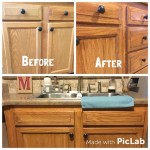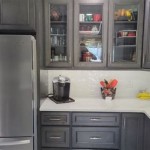How To Adjust Kitchen Cabinet Doors
Misaligned kitchen cabinet doors are a common household annoyance, detracting from the overall aesthetic of the kitchen and potentially hindering functionality. Whether the doors are sagging, rubbing against each other, or refusing to close properly, adjustments are usually straightforward and can be accomplished with basic tools. Understanding the mechanisms involved and systematically addressing common issues can restore the visual appeal and functionality of kitchen cabinetry.
This article provides a detailed guide on how to adjust kitchen cabinet doors, covering various types of hinges and troubleshooting common misalignment problems. The information presented is designed to enable homeowners to perform these adjustments independently, saving time and money on professional repairs.
Understanding Cabinet Door Hinges
The first step in adjusting kitchen cabinet doors is understanding the type of hinges installed. There are generally three main types: standard, European (also known as concealed or Euro-style), and wrap-around hinges. Each type has its own method of adjustment, so identifying the correct hinge is crucial for successful adjustments.
Standard Hinges: These are the most traditional type of hinge, typically found on older cabinets. They are fully visible when the cabinet door is closed. Adjustments are usually made by loosening the screws attaching the hinge to the door and the cabinet frame, allowing for minor repositioning. Shim can be used to compensate for larger gaps or warped doors.
European Hinges (Concealed Hinges): These hinges are hidden when the cabinet door is closed, providing a cleaner, more modern look. European hinges are characterized by multiple points of adjustment, offering more precise control over the door's alignment. They typically feature screws that adjust the door vertically, horizontally (side-to-side), and in and out (depth).
Wrap-Around Hinges: Wrap-around hinges, as the name suggests, wrap around the edge of the cabinet frame. Similar to standard hinges, they are visible when the door is closed. Adjustment is typically achieved by loosening the screws and repositioning the hinge. Shimming might also be required for significant adjustments.
Before proceeding with any adjustments, it's advisable to examine the hinges closely to determine their type and observe how they are attached to the door and frame. This preliminary assessment will inform the approach to the adjustment process.
Common Cabinet Door Misalignment Issues and Solutions
Several issues can lead to misaligned cabinet doors. Recognizing the specific problem is key to implementing the correct adjustment strategy. Common issues include sagging doors, doors that rub against each other, doors that don't close properly, and doors that are not flush with the cabinet frame.
Sagging Doors: Sagging doors occur when the hinge screws become loose or stripped, causing the door to droop. To fix this, first attempt to tighten the existing screws. If the screws are stripped, replace them with longer or thicker screws. In some cases, toothpicks or wood glue can be inserted into the screw holes to provide a better grip for the screws. For severe sagging, consider relocating the hinge slightly or using a reinforcement plate to add support.
Doors Rubbing Against Each Other: When adjacent cabinet doors rub against each other, it indicates that the doors are not properly aligned horizontally. With European hinges, the horizontal adjustment screw should be turned to move the door either left or right. For standard or wrap-around hinges, loosening the screws and carefully shifting the door will correct the issue. Ensure there is consistent spacing between the doors after adjustment.
Doors Not Closing Properly: Doors that won't close properly may be due to a number of factors, including misalignment, obstructions within the cabinet, or issues with the hinges themselves. Begin by inspecting the cabinet interior for anything that might be blocking the door. Then, check the alignment of the door relative to the cabinet frame. Adjust the hinges as needed to ensure a proper seal. If the hinges are bent or damaged, they should be replaced.
Doors Not Flush with the Cabinet Frame: When a door is not flush with the cabinet frame, it may be either protruding too far out or set too far back. Most European hinges have a depth adjustment screw to correct this type of misalignment. Turning the screw usually moves the door in or out, achieving a flush fit. Standard and wrap-around hinges often require shimming behind the hinge plate to achieve the desired depth.
Troubleshooting cabinet door misalignment requires a systematic approach. Start with the most obvious potential causes and work through the possible solutions until the problem is resolved. Careful observation and patience are essential for achieving the best results.
Step-by-Step Guide to Adjusting European Hinges
European hinges offer the most versatile adjustment options. Understanding how to adjust these hinges is crucial for achieving precise alignment. The following steps provide a detailed guide to adjusting European hinges effectively.
1. Identify the Adjustment Screws: European hinges typically have three adjustment screws: one for vertical adjustment (up and down), one for horizontal adjustment (side to side), and one for depth adjustment (in and out). Refer to the hinge manufacturer's instructions if unsure about the function of each screw.
2. Vertical Adjustment: To adjust the door vertically, locate the vertical adjustment screw, usually located at the top or bottom of the hinge. Turn the screw slightly in one direction and then close the door to check the alignment. Continue adjusting until the top and bottom edges of the door are aligned with the surrounding doors and cabinet frame. Observe the door's relationship with the adjacent doors. If the door is sagging, adjust it upwards. If it's too high, adjust it downwards. Small adjustments are key.
3. Horizontal Adjustment: The horizontal adjustment screw is used to move the door left or right. This is particularly useful for correcting doors that rub against each other. Turn the screw gradually and check the door's alignment after each adjustment. The goal is to create an equal gap between the doors. Adjust until there is a consistent, even space between the doors, ensuring they do not rub.
4. Depth Adjustment: The depth adjustment screw controls how far the door sits in relation to the cabinet frame. This is important for achieving a flush fit. Turn the screw clockwise to move the door inward and counterclockwise to move it outward. Adjust until the door is flush with the surrounding cabinets or the desired aesthetic is achieved. Ensure the door closes securely and does not protrude excessively from the cabinet frame.
5. Tighten Screws and Test: After making all necessary adjustments, tighten all the screws on the hinge to secure the door in its new position. Open and close the door several times to ensure it moves smoothly and stays in alignment. If the door still requires adjustment, repeat the process until the desired result is achieved.
Adjusting European hinges requires patience and attention to detail. Small adjustments, followed by thorough testing, are crucial for achieving optimal results. If encountering significant resistance or difficulty, consult the hinge manufacturer's documentation or seek professional assistance.
Finally, regular maintenance, such as tightening screws periodically and cleaning hinges, can prevent future misalignment and extend the lifespan of kitchen cabinets. By following these guidelines, it is possible to maintain the aesthetic appeal and functionality of kitchen cabinetry and avoid costly repairs.

3 Simple Ways To Adjust Kitchen Cabinet Doors Wikihow

How To Adjust Your Kitchen Cupboard Doors Made Easy

3 Simple Ways To Adjust Kitchen Cabinet Doors Wikihow

How To Adjust Your Kitchen Cabinet Hinges Solid Wood Cabinets Information Guides

How To Adjust Kitchen Cupboard Hinges The Big Idea

How To Adjust Your Kitchen Cabinet Hinges Solid Wood Cabinets Information Guides

3 Simple Ways To Adjust Kitchen Cabinet Doors Wikihow

Cabinets Around The House How To Fix A Crooked Kitchen Cabinet Door

Cabinet Hinge Adjustment Hinges For Cabinets Diy Home Repair Repairs

How To Adjust Kitchen Cabinet Doors And Hinges The Lark
Related Posts








